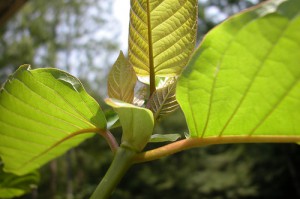
 Kratom: Legal in the US but Illegal in Thailand
Kratom: Legal in the US but Illegal in Thailand
By Nichole Osinski
The tropical deciduous tree Kratom may be native to Thailand but it is still illegal to use it in the country. Traditionally chewed by people in Thailand, especially in the southern peninsula, in the past kratom has been seen has part of the culture. But kratom, also known as Thang, Thom, and Biak, was not originally banned because of substance abuse. When the Thai government started levying taxes from users and shops involved in the opium trade many users switched to kratom to manage their withdrawal symptoms. The Greater East Asia War in 1942 and declining revenues from the opium trade eventually suppressed the opium market competition by making kratom illegal.
The Kratom Act, passed in 1943, makes planting the kratom tree in Thailand illegal while existing trees can be cut down. Many of the poorer classes in southern Thailand have continued to pick and use the leaves that continue to grow in the jungles of the southern provinces. Leaves may be sold illegally to other parts of Thailand but a majority of workers use them for their own personal use.
In 1979 kratom was included in the Thai Narcotics Act along with cannabis and mushrooms, reducing sentences and punishments from those guilty under the act. An increase in the number of arrests and seizures related to kratom were reported at the beginning of the 21st century. Around this time kratom was rising in popularity as stronger narcotic ‘cocktail’ from boiling the leaves and adding cough syrup, Coco-Cola and ice. The drink puts users in a sleepy stupor and the low price-20 leaves, which can make several cocktails-cost the equivalent of US$3.
This cocktail, called ‘4×100’, is becoming abused by younger locals especially young Muslims in Bangkok. Because the kratom drink causes a similar feeling to drinking alcohol, which is prohibited in Muslim religious regulations, a number of Muslims have reverted to drinking kratom. In the U.S. there have been no reported cases of death due to kratom, however, a corpse autopsied at the Institute of Forensic Medicine, Police Hospital, The Royal Thai Police Headquarters raised suspicion that the death was caused by ‘4×100’ intoxication.
According to Donald G. Barceloux, a study of Thai kratom users showed that almost all were men and that 90 per cent either chewed fresh leaves, ate the ground dried leaf, or drank an infusion of the dried leaves. At low doses, the leaves act as a stimulant, whereas higher doses give the user more of an opium effect of relaxation.
Though users both in Thailand and abroad may swear by the drug’s ability to both calm and energize, long-term usage can lead to hallucinations, delusions, tremors, and aggression.
Thai drug law strictly forbids the use and selling of kratom. Chewing the kratom leaf has become commonly accepted in various Thai communities and is popular because of its low cost, difficulty to detect in use, and acceptance amongst villages members.
While Thai authorities continue to try and crack down on the leaf, in western countries such as the U.S. it is legal in many areas. Large quantities of leaves are exported from Southeast Asia to North America and Europe for re-distribution. According to the DEA, the wide availability of kratom on the internet suggests that demand is extensive. In countries such as Denmark and Finland kratom is controlled while Romania, South Korea, Thailand, and Myanmar have made it illegal.
Kratom that is sold legally is usually not sold in its original form but as an extract that is much more potent than what is being used in Thailand. One such example is the mitragynine alkaloid found in the kratom leaves. This is an alkaloid, or chemical compound, that has been isolated from the leaf that is one of the components that can stimulate users Altogether over 22 alkaloids have been isolated from kratom leaves and the quantities contained in various commercial preparations vary according to the method of extraction and from which region the plant was obtained. The varying levels of kratom are labeled by numbers such as 10x, 20x, and so on.
Kratom users on Erowid have recorded their experiences with the following results: one everyday user noted a need and desire to increase the dosage each day and when trying to quit suffered psychological cravings that turned into restlessness and depression leading back into a cycle of kratom usage. Another user recorded relaxed sensations and after higher doses a psychedelic state of mind where they saw a hand coming toward them, a woman’s face, and at one point forgot to breath. A third user who used a 15x extract of ½ a teaspoon considered the kratom three times stronger than Hydrocodone with feelings of “euphoria” where lights and colors were “enhanced.” A final user to drank the highest concentration of kratom extract (.25g) experienced such violent stomach pains and inability to breath they were forced to be treated at the ER.
Due to an increasing number of people using kratom the Drug Enforcement Administration has added it to its list of “drugs and chemicals of concern.” Recently the drug has been under scrutiny by states such as Indiana and Louisiana over concerns of abuse.


According to your last statement where an individual was sent to E.R. It was NOT solely caused by kratom but accompanied with hydromorphone
I think kratom should be legal in all countries, because I think it have no bad effect on someone performances it only help people with pain relief, which is a good thing.